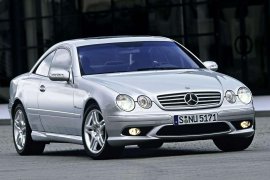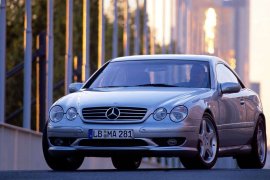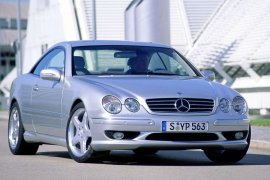MERCEDES BENZ CL AMG Models/Series Timeline, Specifications & Photos
First production year: 2000
Engines: Gasoline
Body style: Coupé (two-door)
More power, reduced fuel consumption and still a comfy and luxurious car. As we already know, AMG models are typically the most expensive and highest-performing variants of each MB model.
The facelifted premium coupe had a starting price of $151,500 in the U.S., and with the Performance Pack option would go up to $158,800.
The CL lacked the B pillar and gave passengers the feeling of airiness, mostly when the windows were open. As comfy as this car might be, it was a bit difficult to access the rear seats – even with the front seats maximally scooched forward. Comparison to its predecessor, the facelift brought a few design changes, as both the front and rear bumper, front grille and headlights were revamped.
The new engine powering the model was a 5.5-liter bi-turbo V8 and was based on a Mercedes-Benz design, unlike the previous version, which had a naturally aspirated 6.2-liter V8 designed in-house by AMG. The new one develops 544 horsepower and up to 571 HP with the optional Performance Pack. It could reach 60 mph (97kph) in 4.4 seconds, aided by a 7-speed automatic transmission.
The car is equipped with a 8” LCD screen, a Comand infotainment system, and most of its settings can be managed through it. A generous array of standard safety items was implemented: seatbelts with pre-tensioners and force limiters, dual stage front airbags, active neck-pro head restraints, attention assist (tracks eye movement and driving patterns indicating fatigue), adaptive high-beams, etc.).
While the CL was designed mostly as a personal luxury coupe, a two-door version of the brand’s flagship S-Class, the S 65 AMG was something special. It was a potent car that could threaten any other Gran tourer vehicle on an Autobahn and win by a large margin.
Mercedes-Benz introduced the second generation of the CL-Class in 2006 and gave it enough power to be an excellent gran tourer. But customers asked for more. As a result, four years later, in 2010, the automaker introduced the facelifted version of the CL-Class C216 model. In addition, it offered it with two AMG versions.
While the CL 63 was more common, the CL 65 was scarce, mostly because it was one of the most expensive vehicles in the automaker’s stable. Unlike the 63 version, which sported a twin-turbocharged V8, the CL 65 came fitted with a monster bi-turbocharged V12. In fact, it was so powerful and produced so much torque that the automaker couldn’t fit it with the newly developed seven-speed automatic gearbox. It had to rely on its older, indestructible 5G-Tronic transmission.
From the outside, the CL 65 AMG sported an unassuming look, featuring a chromed horizontal slat on the grille and the AMG-specific lower bumper that sported an A-shaped grille. In addition, the automaker placed two functional side scoops that cooled the front rotors and housed the LED daytime running lights.
From its profile, bystanders could notice the V12 Biturbo chromed badges from the front fenders and the aerodynamically profiled side sills. At the back, the large quarter panels covered the 275/35 tires wrapped around 20” light-alloy wheels. For the rear fascia, the only details that made the car stand out from the rest of the CL range were the diffuser placed below the bumper and the four oval exhaust tips that flanked it in two pairs.
Inside, the automaker covered most of the parts with Alcantara or leather, depending on the options. The sport bucket seats featured high bolstered areas and a unique pattern on them. Between the front occupants, Mercedes-Benz installed a fat center console that housed the gear selector and a couple of buttons for various functions of the car. Fronting the driver was a CL 65 AMG-specific instrument cluster where the speedometer took center stage.
Unlike any other Mercedes-Benz produced in those times, this was marked up to 360 kph (224 mph). It was flanked on its left by the fuel gauge and the coolant temperature and on the right by the rev counter. On the center stack, the automaker placed a chromed V12 badge that reminded drivers that it was not an ordinary CL. In the back, Mercedes-Benz installed a bench seat profiled for two passengers. Surprisingly, those two seats were comfortable enough for long trips.
Under the hood, AMG installed a hand-made V12 engine that was helped by a pair of turbochargers to produce a maximum output of 630 PS (621 hp) and a massive torque of 1001 Nm (738 lb-ft). All the oomph went to the rear wheels via a limited-slip differential.
It was the big, true Grand tourer car from the Mercedes-Benz. It was big, luxurious, expensive and, on top of that, very fast. The 2007 CL 63 AMG was a car someone would drive on long distances, with superior comfort and performance.
Basically, the 2007 CL was the S-Class coupe of its era. It was based on the same platform, with about the same price tag but dedicated to the front passengers. It had enough room in the back for two passengers, but most of the time the rear seats were unused.
The AMG version featured a distinctive double-blade grille and a different front bumper with larger air-intakes to help to cool the engine and the brakes. The flared wheel-arches gave the vehicle a wider look, even if it wasn't necessary since the car was already wide. The greenhouse was an arch from the hood to the trunk lid.
Inside, the car featured all the luxury the Mercedes-Benz had on its warehouse. Gazillion adjustments for the front seats included those for the side support, lumbar area, lower seat side support, and so on. It looked like the seats needed their own handbook just to operate them. The same was with the infotainment system. It wasn't a touch-screen, but it had a rotary knob on the center console.
Under the hood there was a big, naturally aspirated V8. It could breathe out through four large exhausts in the back. It was mated with a 7-speed dual-clutch gearbox that could shift smoothly when the car was set on comfort mode, or swiftly when in the sport mode. To keep up with the heavy car, the Mercedes-Benz engineers installed a pneumatically adjustable system named ABC (Active Body Control) to improve the handling.
In 2007, Mercedes-Benz and AMG celebrated 40 years of partnership. To celebrate that, the CL was presented with a special model: the CL65 offered as a 40th-anniversary edition as well.
The CL65 AMG was a big Gran Tourer vehicle built as the coupe version for the S-Class. Even though it didn't share the same look, it was built for the same customers. For those who wanted to travel in the same luxury, but with them behind the wheel, not behind the driver.
The CL65 featured a long hood and streamlined roof sloped to the rear. The twin-round headlights design was started with the E-Class in the late '90s and it was adopted by the C-Class, the CLK, and the CL but not on the S-Class. The car didn't feature a B-pillar and made the car look like a faux-cabriolet when both the front and rear windows were rolled down. On the front fenders, the car featured chromed V12 Biturbo badges with
The interior was fitted with the highest quality materials and the latest technologies available at that time. There was a new premium infotainment unit with a navigation system and premium sound. The leather seats were heated and cooled. Despite being a very powerful car, it wasn't fitted with carbon-fiber trims, but with wood grain. The instrument cluster featured an advanced design with float-like needles. In the tachometer, the AMG V12 Biturbo was shown on white letters.
Under the hood, there was a big 6.0-liter bi-turbo engine. It was limited to 1000 Nm (737 lb-ft) of torque because that was the maximum the 5G-Tronic gearbox could stand. The 7G-Tronic was available on other CL models, but it couldn't stand that huge torque. It was produced in only 777 units before it was withdrawn from the market.
It was one of the most exclusive AMG models ever. Only 40 vehicles were built, to celebrate the 40th anniversary of the Mercedes-Benz CL.
It was easy to differentiate the "40th Anniversary" model from any other CL 65 AMG. The silver paint looked different. A different paint method made the car look like it was dressed in liquid metal and stretched all over the body. It was an AMG special and had the Alubeam Paint Finish name.
The 2007 CL65 AMG featured a large grille on the bumper and two air-scoops on the sides to cool the engine and the brakes. To light the road ahead, dual-xenon headlights were installed. Two chromed stripes were horizontally placed on the grille, supporting the big, round, Mercedes-Benz badge in the middle. The side sills were sculpted to improve the air-flow. In the rear, two twin-oval exhausts were coming under the bumper. The big, 20" light-alloy wheels had a specific AMG twin-spoke design.
Under the long hood was a twin-turbo V12 engine. Its massive torque was electronically limited to 1000 Nm (737.5 lb-ft) due to the gearbox limitation. The torque was just too big for the sturdy 5G-Tronic gearbox. The CL 65 AMG featured the AMG SPEEDSHIFT 5-Speed Auto with Steering-Wheel Shift Paddle. To stop the car, 390 mm (15.3") upfront and 365 mm (14.3") rear composite blind-drilled brake discs were installed.
MERCEDES BENZ CL 65 AMG 40th Anniversary (C216) 6.0 V12 5AT (612 HP)
Mercedes-Benz had a long history in building luxury coupe vehicles and the CL was one of them. But in 2003 they went all the way and give the car an AMG treatment.
Before the S-Class name was born, most of the top versions of the Mercedes-Benz cars were available in coupe or cabriolet versions. They were equipped with the same engines and transmissions as their four-door brothers. The CL was considered an S-Class coupe at the time when it was launched, even if it didn't share the same exterior look.
At the front, the CL65 AMG featured four round headlights, that were about to be installed in the E-Class and, a year later on the second generation of the CLK. That four-round headlights design was adopted on the C-Class, the E-Class, and on both generations of the CLK. The front of the car also featured an AMG bumper, with a special design with a large air-dam in the middle and two side pods where the fog lights were installed.
Inside, the CL 65 AMG featured the same elegant interior as its brothers, but there were few differences. On the instrument cluster, on the tachometer, the AMG V12 Biturbo white-on-black printing appeared. The front seats were bolstered and featured many adjustments, including the height of the lateral support.
Under the hood, there was the same bi-turbo V12 engine from the S-Class and the SL-Class. It was mated to the 5G-Tronic gearbox. The driver could have change the gears via two buttons installed behind the steering wheel. The paddle shifters appeared later.
In the fall of 2002, Mercedes-Benz introduced the AMG version of the CL, and, along with the supercharged engine, came additional visual upgrades and a revised interior.
When the German carmaker introduced the CL as a personal luxury coupe, it offered an elegant yet sporty vehicle thanks to a few advanced technologies. But, unfortunately, the engines were not exactly that powerful. That problem was fixed when the CL55 AMG version came on the market.
Featuring the same four-headlights front fascia, the AMG version received a new bumper that enhanced the car's aggressive look. Thus, an A-shaped "mouth" flanked by two oval foglamps on the lower bumper created a sportier look for the vehicle. Moreover, the side sills and the rear bumper were replaced with a body kit designed and installed by AMG. In addition, a four-exhaust system with oval, chromed tips warned other drivers that they were just passed by an AMG. Last but not least, a subtle lip spoiler adorned the trunk's lid.
Inside, there was basically the same interior as the rest of the CL range. However, a new set of bucket seats at the front with high-bolstered areas provided better side support for their occupants. Moreover, the carmaker added a pair of paddle-shifters behind the steering wheel so the driver could manually change the gears for the standard automatic transmission.
Under the hood, the manually assembled V8 mill was helped by a supercharger to gain more power and torque. It was paired as standard with a five-speed automatic gearbox that sent the oomph to the rear wheels. Despite the heavy weight of the large, luxurious coupe, the car could rocket from 0 to 62 mph (0-100 kph) in under five seconds.
Mercedes-Benz introduced the CL 55 AMG F1 Edition in 2000 and built it in a limited number of just 55 units. However, the car was not initially developed to be sold on the market but to be a peace car on Formula 1 tracks.
One of the most interesting facts about this exceptional vehicle is that it was the first street-legal vehicle in the world fitted with ceramic brakes. Something that still today is considered one of the most significant improvements in braking technology. But there was more than just the brakes that made this car so special.
When they left the factory, all of these vehicles were painted in the same brilliant silver metallic color and fitted with exactly the same wheels and tires. AMG developed those five-spoke forged wheels, especially for this vehicle. Later, Mercedes' in-house tuner used the same look of those wheels for other AMG-branded cars as well. Still, at first sight, it wasn't that different than other CL 55 AMG vehicles. It sported the same four-headlights front fascia and the A-shaped lower grille flanked by a pair of scoops that hosted the fog lamps. From its sides, the grand tourer featured aerodynamically profiled skirts, while at the back, a dual exhaust system fitted with oval chromed pipes completed the AMG exterior package.
But the interior was different than other regular CL 55 AMG models. When customers opened the doors, the car greeted them with CL 55 AMG F1 illuminated logos on the side sills. The cabin looked simple, with black and silver elements. On the center console, the car manufacturer replaced the regular wood grain fitted on other CL models with carbon-fiber trims, and on the center stack, Mercedes-Benz installed an infotainment system with a color display and featured phone connectivity for calls. Another specific element for this limited-edition version was the high-bolstered sports seats for the front occupants. They featured integrated headrests adorned by the embroidered AMG logo. In the back, the automaker installed a bench seat profiled for two and wearing leather upholstery.
The automaker developed the CL 55 AMG F1 to be used on Formula 1 tracks as a peace car. As a result, there were many specific parts of the vehicle that were suitable for high-speed driving and hard cornering situations. That's why it also featured ceramic brakes developed together with Brembo. Under the hood, AMG installed a hand-built V12 powerplant that produced 360 PS (355 HP) from a 5.4-liter displacement. All that power was sent to the rear wheels via a five-speed automatic transmission known as the 5G-Tronic. AMG also tuned the four-wheel independent suspension for tracks, even if that diminished the car's ride quality. But on the other hand, the vehicle had to be able to keep up with the high speeds required on an F1 track.
By the 2000s, Mercedes-Benz was the only German carmaker that offered a true Grand Tourer coupe, and besides the regular versions, it provided an AMG-tuned one that could be more than just a trans-continental comfortable ride.
After BMW stopped the 8-Series, Mercedes-Benz was left alone on the niche-market of Grand Tourer vehicles. The CL C215 was a true personal luxury coupe built for long distances that could offer the same comfort level as an S-Class. Since it was a car focused on the driver, the carmaker decided to add an AMG version: the 55 AMG.
Its double-headlights design matched the line introduced by the E-Class W210 and continued by the CLK C208 and the C-Class W203, but with a more refined look. In AMG clothing, it sported an A-shaped lower bumper that wore a pair of oval fog lights. Its three-slats grille that supported the big, three-pointed-star logo was different than the rest of the C215 range. The aerodynamic package continued with sculptured rocker-panels and, in the back, a tiny lip on the trunk lid and a specific bumper design.
Inside, the carmaker showed its respect to its customers and installed a luxurious, well-equipped cabin. The customer could choose between wood-trims and carbon-fiber trims for the interior. Its front bucket-seats offered a mix of comfort and sporty feeling due to their side bolstering.
The 1999 CL 55 was the first AMG special for the big, luxury coupes built by Mercedes-Benz. Besides the supercharged V-8 engine, the Gran Tourer featured standard adaptive suspension that reduced body roll and a five-speed automatic transmission with a Steptronic system. That allowed the driver to manually select the gears by tilting the gear-selector left or right.








